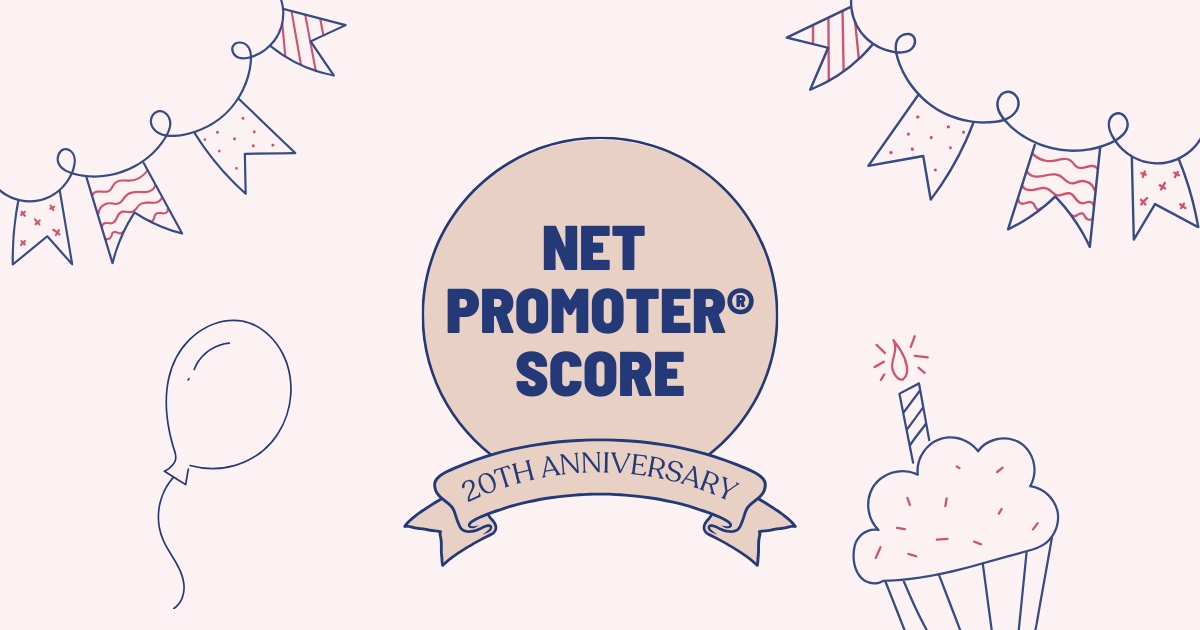In the dynamic world of customer experience, the Net Promoter@ Score (NPS) has been unraveling the intricacies of customer sentiment and loyalty for the past twenty years. As we celebrate this milestone, we’ll explore the origins of NPS, its benefits as a growth catalyst, and its resilience amid challenges.
Join us on the NPS anniversary through NPS’s history, acknowledging the minds behind its creation and early adopters. We’ll navigate the terrain of benefits, where NPS has been used to not only measure but steer companies toward growth and lasting customer relationships.
Brief History of the Net Promoter® Score
The Net Promoter Score (NPS) originated in 2003, conceived by Fred Reichheld, a partner at Bain & Company, and introduced through his seminal article in Harvard Business Review. Reichheld aimed to simplify customer feedback and loyalty measurement, giving rise to the straightforward question, “How likely are you to recommend our product/service to a friend or colleague?” The methodology categorizes respondents into promoters, passives, and detractors based on their likelihood to recommend, establishing a numerical scale.
NPS gained rapid traction, becoming a staple in business strategy due to its simplicity and actionable insights. Early adopters, including industry leaders like Apple and General Electric, recognized its potential to measure customer loyalty effectively. By the mid-2000s, NPS had permeated various sectors, cementing its status as a pivotal metric in the customer experience. The history of NPS underscores its journey from a conceptual framework to a ubiquitous tool, shaping how businesses gauge and enhance customer satisfaction.
Benefits of NPS
The Net Promoter Score delivers multifaceted benefits that propel businesses toward customer-centric success. In the following paragraphs we’ll discuss the key benefits of the Net Promoter Score:
Catalyzing Growth and Retention
According to a 2006 Bain and Company study, the NPS acts as a catalyst in driving growth and customer retention. The study revealed that NPS leaders consistently outpaced their rivals more than two times, affirming the role of the metric NPS as a springboard for sustainable market share expansion.
Informed Excellence
Companies leveraging NPS to identify pain points experience a 20% or more boost in customer satisfaction. NPS transcends guesswork, providing a robust foundation for strategic planning and continuous improvement as a wealth of statistics from NPS surveys can be transformed into actionable inisights that propel data-driven decision making.
Enhanced Customer Advocacy
The NPS serves as a potent tool for converting detractors into promoters. As per a global NPS benchmark report, companies adept at addressing detractor concerns witnessed a 50% increase in customer advocacy. The possibility to turn feedback into loyalty and advocacy position the NPS as a proactive driver of positive word-of-mouth.
Operational Efficiency
NPS insights can play an instrumental role in enhancing operational efficiency by precisely identifying areas for improvement. Empirical research underscores that businesses integrating NPS feedback into their operations realize a 25% reduction in service costs. Observe how NPS intricately streamlines internal processes beyond its impact on customer satisfaction. This seamless integration ensures a harmonious equilibrium between operational excellence and the pursuit of customer delight, positioning NPS as a strategic ally in optimizing business operations.
NPS Challenges and Criticisms
Despite its popularity, the Net Promoter Score has yet to be immune to scrutiny and critique. Over the course of the last two decades, challenges and criticisms that have emerged, shedding light on potential pitfalls that businesses should be aware of in their pursuit of measuring the customer experience using the NPS.
Potential Bias in Feedback
The simplicity of the NPS question, “How likely are you to recommend our product/service to a friend or colleague?” may inadvertently lead to biased feedback. A survey by CustomerGauge found that 30% of respondents felt the NPS question didn’t capture their whole experience, hinting at potential biases introduced by the simplicity of the metric. This underscores the importance of acknowledging that a singular question might not accurately encapsulate the complexity of customer sentiments.
Oversimplification of Customer Loyalty
While providing a straightforward categorization, the classification of respondents into promoters, passives, and detractors oversimplifies the intricate nature of customer loyalty. According to a study by Forrester Research, 45% of businesses find it challenging to translate NPS into actionable strategies due to oversimplified categorization. This limitation raises concerns about overlooking the nuanced reasons behind customer loyalty, potentially hindering the development of targeted improvement initiatives.
Neglect of Neutral and Negative Feedback
Critics argue that NPS prioritizes positive feedback, potentially neglecting valuable customer insights in the neutral or negative categories. A survey by Medallia revealed that 25% of customers who gave neutral or negative NPS scores felt their concerns needed to be adequately addressed. This criticism highlights the need for businesses to ensure an equal and thorough examination of feedback across all categories to drive holistic improvements.
Industry-Specific Variation
NPS effectiveness exhibits variations across industries, raising concerns about its universal applicability. A report by the Temkin Group showed that industries such as healthcare and utilities tend to have lower average NPS scores compared to sectors like technology and retail. Understanding these industry-specific nuances is crucial for interpreting NPS data accurately and tailoring strategies to the unique challenges within each sector.
Limited Contextual Understanding
A significant challenge associated with the NPS lies in its inability to provide context for the feedback received. A study by Qualtrics revealed that 60% of businesses need help understanding the context behind NPS. With context, interpreting the meaning behind scores becomes easier, enabling businesses to making informed decisions. This limitation underscores the importance of supplementing NPS with additional qualitative data to enrich the understanding of customer sentiments.
Competing Metrics
In the realm of customer experience metrics, a spectrum of tools, including Net Promoter Score (NPS), competes for attention alongside Customer Satisfaction Score (CSAT), Customer Effort Score (CES), Customer Lifetime Value (CLV), Customer Retention Rate, and Churn Rate. Each metric brings unique strengths and weaknesses, catering to distinct aspects of the customer journey.
Net Promoter Score (NPS)
Strengths: Provides a concise measure of customer loyalty and advocacy, offering a forward-looking perspective. Its simplicity allows for widespread adoption.
Weaknesses: Limited in-depth insights; categorizing promoters, passives, and detractors may oversimplify customer sentiments.
Customer Satisfaction Score (CSAT)
The Customer Satisfaction Score (CSAT) measures how satisfied customers are with a product, service, or overall experience provided by a company. It is often assessed through surveys where customers are asked to rate their satisfaction on a numerical scale or using descriptive terms.
CSAT is used. to gauge overall customer satisfaction, identify areas for improvement, and track changes in customer sentiment over time. High CSAT scores generally indicate that customers are content with the provided products or services, while lower scores may prompt businesses to investigate and address potential issues.
Strengths: CSAT surveys deliver immediate feedback after an interaction making the metric versatile for assessing satisfaction across different touchpoints. Additonally, CSAT scores can be benchmarked over time to track changes in customer satisfaction and to compare performance against industry benchmarks or competitors.
Weaknesses: CSAT lacks granularity as it doesn’t always reveal the specific reason behing a customers’ satisfaction of dissatisfaction. Furthermore, interpretation of satisfaction can be subjective as different customers have different expectations and perceptions of a “satisfactory” experience.
Customer Effort Score (CES)
The Customer Effort Score (CES) is used to measure the ease with which customers can complete a specific task or achieve a goal with a company, typically related to their interaction with a product, service, or support. It is designed to assess the level of effort a customer has to exert in order to get a resolution or accomplish a particular objective.
A lower CES generally indicates that customers find it easy to interact with a company and are more likely to have a positive experience. Reducing customer effort is often associated with increased customer satisfaction and loyalty. Companies use CES as a key performance indicator to identify areas where they can simplify processes and enhance the overall customer experience.
Strengths: Measures the ease with which customers can achieve their goals. It reflects the efficiency of customer interactions.
Weaknesses: It might not capture the full spectrum of customer emotions or loyalty. Primarily focused on transactional experiences.
What’s Your Customer Effort Score?
Customer Lifetime Value (CLV)
Customer Lifetime Value (CLV or LTV) represents the total revenue a business can expect to earn from a single customer throughout their entire relationship. In other words, it quantifies the value of a customer to a business over the course of their engagement.
Calculating CLV involves considering factors such as the average purchase value, the frequency of purchases, and the duration of the customer’s relationship with the business. A higher CLV generally indicates a more profitable and sustainable customer base.
Strengths: Quantifies the total value a customer brings to a business over their entire relationship. Crucial for strategic resource allocation.
Weaknesses: Complex to calculate accurately; requires historical data and assumptions about future customer behavior.
Churn Rate
Customer Churn Rate is a business metric that measures the percentage of customers who stop using a product or service over a given period of time. It is a crucial metric for businesses, especially in subscription-based models or industries where customer retention is essential.
The churn rate is typically calculated as the number of customers lost during a specific time period divided by the total number of customers at the beginning of that period, multiplied by 100 to express it as a percentage.
Strengths: It quantifies the percentage of customers who discontinue their relationship with a business. It offers insights into customer dissatisfaction or external market factors.
Weaknesses: Provides information afterward; businesses may lose customers before detecting issues.
Customer Retention Rate
The Customer Retention Rate measures the percentage of customers a business has retained over a specific period. Unlike churn rate, which focuses on the customers lost, retention rate emphasizes the customers that a business has managed to keep.
A high customer retention rate is generally a positive indicator, suggesting that a business is successful in keeping its existing customers satisfied.
Strengths: Measures the percentage of customers retained over a specific period, reflecting loyalty and satisfaction.
Weaknesses: Does not differentiate between satisfied and dissatisfied retained customers. It might not capture overall customer sentiment.
Choosing the right metric depends on business objectives and the specific aspect of the customer experience under consideration. NPS excels in predicting customer advocacy, while CSAT and CES offer transactional insights. CLV, Customer Retention Rate, and Churn Rate focus on customer relationships’ long-term value and health. The optimal approach often combines multiple metrics to understand the diverse facets of customer experience comprehensively.
The Current State of NPS Metric
In the contemporary realm of customer experience assessment, the Net Promoter Score (NPS) retains its prominence as a pivotal metric widely adopted by businesses looking to decipher customer satisfaction and boost the customer experience. Its present-day relevance is underscored by its simplicity, versatility, and adaptability.
For many businesses across diverse industries, the NPS has evolved beyond a mere metric; it is now a strategic key performance indicator (KPI) that gives organizations a pulse on customer relationships.
In the financial sector, a bank’s focus on elevating NPS scores translated into a remarkable 30% increase in customer loyalty and a subsequent 25% surge in the average customer lifetime value. This showcases how NPS goes beyond measuring satisfaction to influencing crucial financial metrics, demonstrating its holistic impact on various facets of business performance.
As organizations navigate the complex landscape of customer-centric strategies, NPS remains a robust tool, offering a concise measure of customer satisfaction and loyalty. However, companies are becoming more and more aware of the limitations of the NPS with organizations shifting their attention to AI technologies to mitigate the challenges with which the NPS is associated and enhance their understanding of their customers.
How AI is Revolutionizing the NPS
Integrating Net Promoter Score (NPS) with AI-powered analytics is a revolutionary advancement transforming how businesses collect, analyze, and act upon customer data.
Enhanced Data Collection, Analysis, and Interpretation
AI technologies bring unprecedented efficiency to NPS data processing. Natural Language Processing (NLP) algorithms enable text analysis and sentiment analysis, allowing businesses to discern the emotional nuances in customer responses and contextualize the customer experience. Machine learning algorithms refine data interpretation over time, ensuring a more accurate understanding of customer sentiments.
Automating Follow-Up Actions and Personalized Responses
AI-driven automation streamlines the post-NPS feedback process enabling businesses to successfully close the feedback loop. This enables businesses to identify patterns in customer responses and conversations, automating follow-up actions based on predefined criteria.
This not only accelerates response times but also allows for personalized interactions. For instance, AI can promptly trigger automated workflows to address their concerns if a customer expresses dissatisfaction in an NPS survey.
What is Personalized Customer Service?
Conversational Analytics
Over the last few years Artificial Intelligence has introduced a new era of customer intelligence – one where businesses can not only measure customer satisfaction more accurately but also predict it by analyzing existing historical data in combination with real-time customer conversations. Conversational analytics holds the power to transform the way businesses understand the customer experience and forecast satisfaction levels based on individual customer interactions.
Conversational Analytics – Benefits and Use Cases
When used properly, the predictive power of AI analytics can be an invaluable tool which could address the NPS challenges mentioned in the previous paragraphs. For example, conversational analysis can enhance your understanding of what drives your promoters, detractors and passives as well as offer the context that is missing from NPS measurement.
Business Examples
Several businesses have successfully harnessed AI-powered analytics to elevate their NPS initiatives. Take the example of an e-commerce giant utilizing machine learning to analyze NPS feedback. The company identified pain points in the customer journey by automatically categorizing and prioritizing responses, leading to targeted improvements and a subsequent boost in NPS scores.
In the telecom industry, an AI-enhanced NPS approach facilitated proactive issue resolution. Machine learning algorithms flagged potential service disruptions based on NPS feedback, enabling the company to address issues before widespread customer impact, resulting in improved satisfaction and reduced churn.
Additionally, a financial institution implemented AI to personalize responses to NPS feedback. The system generated tailored responses by analyzing customer interactions and preferences, fostering a sense of being heard and valued. This personalization not only enhanced customer satisfaction but also contributed to increased loyalty and positive word-of-mouth.
The integration of AI with NPS not only expedites processes but also adds a layer of intelligence to customer service strategies. Businesses can enhance customer satisfaction and proactively address issues by automating tasks, providing personalized responses, and extracting actionable insights, ultimately contributing to a more robust and responsive customer experience.
The Future of NPS
The future of the Net Promoter Score (NPS) promises to be shaped by technological advancements and emerging trends in customer experience measurement. Artificial intelligence and machine learning are anticipated to play pivotal roles in refining NPS analytics, with companies like Salesforce reporting a 33% increase in customer satisfaction through AI-driven insights.
Predictive analytics is emerging as a significant trend, allowing businesses to forecast customer behavior based on historical data. For instance, Gartner predicts that by 2023, 40% of customer service organizations will leverage AI to augment customer engagement.
There’s a growing emphasis on real-time, omnichannel feedback collection to adapt NPS for the future. According to a Forrester survey, 73% of companies prioritize improving customer experience across channels, indicating a shift towards more holistic feedback mechanisms.
While NPS is likely to remain a dominant metric, adaptation is essential. The question of its continued dominance is nuanced, as evidenced by the growing popularity of the Customer Effort Score (CES). As companies embrace new methodologies, the future of NPS will rely on its ability to evolve, incorporating innovations that align with changing customer expectations and technological capabilities.
Wrapping Up
In conclusion, our exploration of the Net Promoter Score (NPS) has illuminated its enduring significance in the customer experience realm. From its inception two decades ago to its present-day integration with AI and analytics, the NPS anniversary remains a linchpin for businesses seeking to measure customer satisfaction and loyalty. The history unveiled the simplicity that became its strength, while the benefits showcased its impact on growth and retention.
Despite common challenges and criticisms, NPS continues to thrive, adapting to industry-specific nuances and technological advancements. Incorporating AI has streamlined data analysis and empowered businesses to automate responses and foster personalized interactions.
As we ponder the future, the trajectory of NPS appears poised for evolution, embracing trends like predictive analytics and omnichannel feedback.
Its enduring importance lies in its ability to encapsulate customer sentiments succinctly, shaping the future of customer feedback and steering businesses toward ever-improving customer-centric strategies.
In this dynamic landscape, NPS stands as a stalwart metric, navigating the currents of change and contributing to the ongoing evolution of customer experience measurement.
Did you like the post?
You might also like:

Surveypal
Everything you need to lead and improve your customer experience. Learn more at surveypal.com, or










